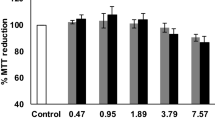Summary
Anthocyanins are common colored plant flavonoids, occurring as glycosides of the respective anthocyanidin-chromophores. Like other flavonoids, anthocyanidins are also expected to have antioxidative and antimutagenic properties in vivo, although only few data are available. To gain more knowledge on possible protective mechanisms in mammalian cells, we have compared their extracellular and intracellular antioxidative potential in vitro and in human colon tumor cells. We used Aronia melanocarpa Elliot anthocyanin (AA) concentrates, fractions thereof, concentrates from Elderberry, Macqui, and Tintorera fruits, as well as pure compounds. In vitro, antioxidative properties of the samples were studied with the ferric reducing ability assay (FRA assay). As a measure of intracellular oxidative/antioxidative effects, H2O2-induced strand breaks as well as oxidized DNA bases were determined in human tumor HT29 clone 19A cells using a microgelelectrophoresis assay (comet test). Major results were that isolated compounds (aglycons and glycosides) and complex plant samples are powerful antioxidants in vitro. In fact their activities by far exceeded those of Trolox and vitamin C in the FRA assay. Also H2O2-induced DNA strand breaks were reduced in cells treated with the complex plant extracts. In contrast, endogenous generation of oxidized DNA bases was not prevented. In summary, the intracellular steady state of oxidized DNA bases is not altered by anthocyanins or anthocyanidins. This findings raises questions with respect to the cancer preventive potential of anthocyanidins within specific tissues, such as the colon. Extracellularly, however, the compounds are potent antioxidants. This points to their potential for providing systemic protection in vivo, e.g., by scavenging oxidants in the blood stream and in the colon. Notably, both aglycons and glycosides have equally strong antioxidant activity.
Similar content being viewed by others
Author information
Authors and Affiliations
Additional information
Received: 28 July 1999, Accepted: 8 October 1999
Rights and permissions
About this article
Cite this article
Pool-Zobel, B., Bub, A., Schröder, N. et al. Anthocyanins are potent antioxidants in model systems but do not reduce endogenous oxidative DNA damage in human colon cells. Eur J Nutr 38, 227–234 (1999). https://doi.org/10.1007/s003940050065
Issue Date:
DOI: https://doi.org/10.1007/s003940050065




